
Tron 2.0
Written by: Rik
Date posted: December 28, 2015
- Genre: Action
- Developed by: Monolith
- Published by: Buena Vista Interactive
- Year released: 2003
- Our score: 9
Tron is the kind of film that I’m sure, as a kid, I must have seen on TV at some point, but for whatever reason, nothing about it ever really stuck in the memory, which makes me think that maybe I didn’t. A recent purchase of the DVD, with the aim of clarifying matters, only served to further muddy the waters after I fell asleep at some point in the opening half and woke up as the end credits were rolling. Without ascribing any blame to the film itself (with a day off work booked I arrogantly stayed out late the night before and I’m not as young as I was) I didn’t find it desperately easy to follow: the film is certainly light on exposition, and I was genuinely confused by some of the tech jargon, idly flitting between wondering whether what was being discussed had anything to do with actual 80s computer technology and realising that it obviously was all sci-fi make-believe and mocking myself for having had such a thought in the first place.
Although it’s since become a cult hit, Tron’s underwhelming commercial performance meant that it seemed destined to never receive a sequel in the traditional sense, and someone somewhere presumably felt comfortable giving the ok for a video game – this video game – to serve as a follow-up of sorts. It’s a sequel in that slightly low-budget game-land way, in that some famous people from the film have been persuaded to have a level of involvement and lend it some sense of authenticity, without there ever being a hint of the bigger names returning. (Of course, we eventually got a proper movie sequel, Tron Legacy, which immediately ran roughshod over Tron 2.0’s entry in the timeline, although it did share some similar ideas – see And then, one day…I got in for more).
The titular Tron – or at least its creator, Alan Bradley (Bruce Boxleitner) – makes a return here, this time alongside his son Jet, who quickly falls into “ungrateful young upstart” territory as we see him stropping around and arguing with Alan about various things in the early stages. Inevitably, it is this cocky young whippersnapper with whom the target audience is supposed to identify, and so we take control of Jet as he investigates the mysterious disappearance of his father, having inadvertently become digitised and hurled face first into a confusing alternate universe inside a computer (that’ll learn you some manners, young ‘un).
One of the other main stars of the 1982 movie, Cindy Morgan, also features, but not as her film character Lora/Yori, instead portraying Alan’s computer AI, Ma3a. Obviously, there’s no Jeff Bridges, although his character Flynn is mentioned at various points. Elsewhere, Hollywood actress Rebecca Romijn (Mystique from X-Men!) lends moderate star quality as a supporting character called Mercury.
Tron 2.0 is an FPS, although when you first enter the world, you’re almost as confused as Jet himself (or, worse, as confused as when you fell asleep during the movie in real life). The technojargon makes it seem a much more complicated beast than it is, and I actually found the tutorial on offer here both necessary and useful (although my first reaction was of course, “I’ve played an FPS before”). As you begin to progress, though, it soon becomes apparent that many initially abstract concepts are simply genre staples – for example, permissions, which can be found or dropped by enemies, act as keys; while subroutines are effectively your weapons and armour. The latter can be upgraded to improve effectiveness and efficiency (weapons all use energy which acts as a kind of universal ammunition, although it can be expended in other ways, for example when downloading permissions and subroutines) and must be configured at the start of each level in accordance with the limited amount of memory slots you have available. Although this arrangement can be changed at any time during a level, and doesn’t have enough depth to seriously affect the way you play, it does still mean you’re never an all-powerful megaman with fully upgraded everything available at the touch of a button. Adding a further RPG element, your own general capabilities (e.g. maximum health and maximum energy) can be increased by collecting build versions which are dotted throughout every level (in essence upgrading Jet as if he were a program, represented by a version number in the top left of the screen), and every so often, you’ll be given an opportunity to level up.
Despite everything soon all making sense, the cybertalk does add to the effect of having being transported to another world, complementing the distinctive visuals and stylised environments, which have also helped the game to age more gracefully. It does look very good though – the only really visually creaky bits are the cut scenes set in the real world, which seemingly whisk you back to 1998 or so. (Full disclosure – I did use the ‘Killer App’ mod, which adds higher resolutions and widescreen support).
The setting also has the advantage of disguising otherwise dreary FPS activities – such as precision jumping onto crates or moving platforms – because they make more sense in the world of Tron. Similarly, a shooter with enemies that spawn or respawn from nowhere would normally drive me mad, but here it’s perfectly logical and consistent that they do so. Even when you’re wandering around unsure what to do – another FPS bugbear of mine – the game world is generally just so interesting to be in that you don’t mind so much. Such occasions are rare, partly because the levels are fairly small, but also because you’re given assistance in the form of a list of objectives which tell you what to do next, and help files which remind you exactly what it is you’re looking for (including pictures) and what to do when you find it.
Although there are gun-like weapons, Tron 2.0 never quite descends into complete genre cliché to the extent that you’re running around with thinly-disguised machine guns and grenade launchers. Most of the time, you can get away with using the disc – your first weapon, as seen in the film – or its upgraded version, the sequencer (which bends logic slightly in allowing you to somehow launch a series of discs without having to wait for one to come back). The combat is very satisfying – grunts go down quickly if you get your aim right, but can soon do you some serious damage if you don’t. Of the other weapons at your disposal, I particularly liked a couple of the close combat options – a cattle prod style thing (called – ho ho – a “P-rod”) that you can sneak up and shock enemies with, and a glove that harvests energy from AI opponents (as well as killing them TO DEATH).
The bulk of the story is told through in-engine cut scenes, which occur at about the right frequency, although some optional background and wider context can be accessed as you progress by downloading emails – providing information on Jet’s dynamic with his father, what becomes of Flynn, and the takeover of Encom by Future Control Industries (fCon). I won’t go into too much detail here, but, as with the Tron movies, you’re effectively *adopts Owen Wilson Hansel voice* in the computer. As you enter Alan’s system, you find yourself under attack from two sides: firstly, from programs infected by a virus attacking his computer (known as the corruption) and also from the system’s security countermeasures which mistake you for part of the corruption.
The latter are slightly more fun to fight – the corruption “Z-lots” launch very slow-moving but deceptively difficult to dodge green blobs that can infect your subroutines and disable them, which adds an extra level of irritation – both managing the situation during combat, and then disinfecting once the battle is over. Other enemies include Resource Hogs (slightly tougher grunts) and the fCon DataWraiths (tricky to pin down thanks to cloaking abilities and fast movement), and there’s also the occasional boss battle. You most likely have your own position on boss battles, but I didn’t mind these too much, although one in particular did need a bit of thought (check out Warning: system resources are critical, if you want some help in exchange for mild spoilerage). There are quite a few friendly NPCs too, although dialogue doesn’t – with one exception I noted – involve any choices. It’s not exactly Deus Ex, but there is an extra layer of RPG-lite here that gives it a little more depth than a straight shooter.
There are some truly great set pieces. At one point fairly early on, you find that your machine is going to be reformatted in an attempt to get rid of the corruption: you have to leg it to an exit, as the red formatting cloud looms towards you, fighting enemy corruption as you go, before waiting for a forcefield to be disabled. No matter how much you might know that it’s a scripted set piece that will ultimately mean you escape unscathed (provided you aren’t killed by the corruption), the tension is still palpable.
It’s difficult to pinpoint many really bad bits: I would argue that several climactic-feeling exchanges towards the end would have made for a better finale than the ultimate boss battle used here. There are also a number of light-cycle stages, which I guess is clearly a must for a Tron game, but they don’t quite work as well as they should. It’s not so much the difficulty level that’s problematic – although the camera is a bit dreadful; you can move it around a bit but only through a narrow arc of extremely unhelpful angles – but the edge-of-your-seat thrills are missing. Meaningful duels are rare, and the surest way to progress is to hang around and avoid confrontation, waiting for the opposing cycles to have an accident.
Apart from those things, though, I had few problems with Tron 2.0. As a man who seemingly ignores the stated intentions of this site at will, in a quest to review nothing but rightly-forgotten football and racing games of middling quality, it was quite a pleasant surprise to find that I was not incapable of genuinely enjoying something I wrote about here. As it happens, I liked Tron 2.0 more than anything I’ve played for quite a while, and it would certainly rank among my top FPS games, so it’s a solid, unqualified recommendation from me.

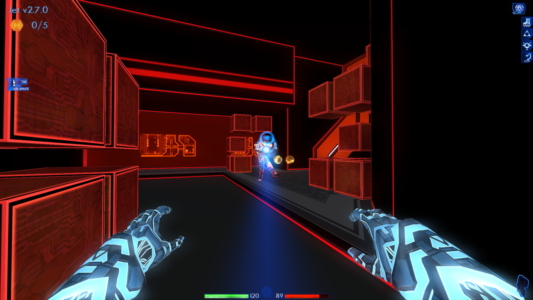
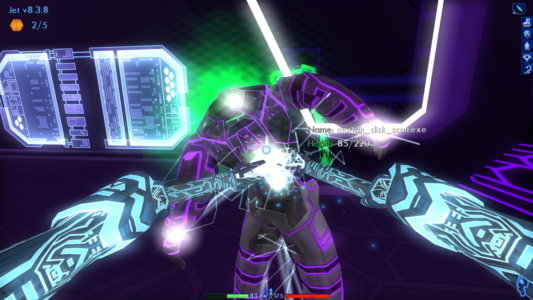
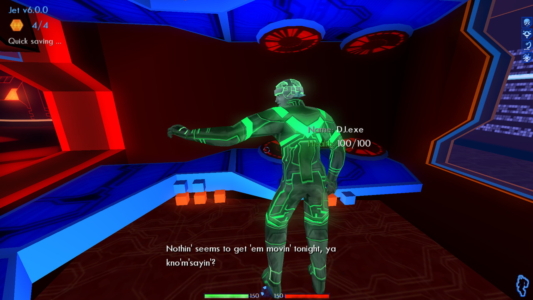
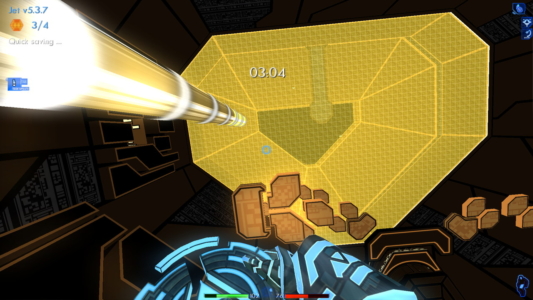
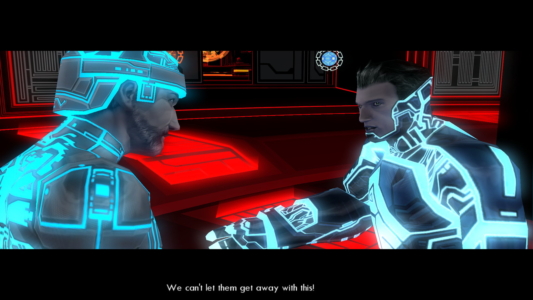

 Posts
Posts
Nice work, as always. If I remember correctly, a big deal was made over the “Tron glow” that nVidia created some custom effects for. Which mysteriously didn’t work on ATI cards.
December 30, 2015 @ 2:28 am
It’s a masterpiece! The music, the details, the story (which wasn’t as engaging in the film) totally captivated me… I liked it better than both movies actually. However I totally agree with the flaws you pointed out.
September 28, 2017 @ 1:15 pm